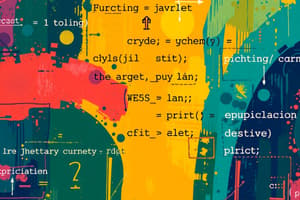Podcast
Questions and Answers
What is the purpose of a function?
What is the purpose of a function?
- To execute a block of code multiple times from different parts of a program (correct)
- To create a new object
- To store a collection of values
- To declare a variable
What is the difference between a function declaration and a function expression?
What is the difference between a function declaration and a function expression?
- A function declaration is defined with a name, while a function expression is anonymous (correct)
- A function declaration is hoisted, while a function expression is not
- A function declaration can take arguments, while a function expression cannot
- A function declaration returns a value, while a function expression does not
What is the purpose of the push() method in an array?
What is the purpose of the push() method in an array?
- To add one or more values to the end of the array (correct)
- To create a new array from a subset of an existing array
- To remove the first value from the array
- To remove the last value from the array
What is the difference between indexOf() and includes() methods in an array?
What is the difference between indexOf() and includes() methods in an array?
What is the purpose of the map() method in an array?
What is the purpose of the map() method in an array?
What is the scope of a variable defined inside a function?
What is the scope of a variable defined inside a function?
What is the purpose of the splice() method in an array?
What is the purpose of the splice() method in an array?
What is the purpose of hoisting in functions?
What is the purpose of hoisting in functions?
What is the default scope of a variable declared outside a function or block scope?
What is the default scope of a variable declared outside a function or block scope?
Which of the following is a characteristic of variables declared with let and const?
Which of the following is a characteristic of variables declared with let and const?
What is the purpose of the prototype chain in object-oriented programming?
What is the purpose of the prototype chain in object-oriented programming?
What is the primary difference between a function declaration and a function expression?
What is the primary difference between a function declaration and a function expression?
What is a closure in the context of functions?
What is a closure in the context of functions?
Which of the following is an example of a primitive type in JavaScript?
Which of the following is an example of a primitive type in JavaScript?
What is the purpose of a constructor in object-oriented programming?
What is the purpose of a constructor in object-oriented programming?
Which of the following is an example of a reference type in JavaScript?
Which of the following is an example of a reference type in JavaScript?
Flashcards
Function
Function
A block of code that can be reused.
Function Arguments
Function Arguments
Values passed to a function when called.
Function Return Value
Function Return Value
Value given back by a function after running.
Function Declaration
Function Declaration
Signup and view all the flashcards
Function Expression
Function Expression
Signup and view all the flashcards
Array
Array
Signup and view all the flashcards
Array Indexing
Array Indexing
Signup and view all the flashcards
Array push()
Array push()
Signup and view all the flashcards
Array pop()
Array pop()
Signup and view all the flashcards
Array shift()
Array shift()
Signup and view all the flashcards
Array unshift()
Array unshift()
Signup and view all the flashcards
Array slice()
Array slice()
Signup and view all the flashcards
Array map()
Array map()
Signup and view all the flashcards
JavaScript Variable
JavaScript Variable
Signup and view all the flashcards
Variable Scope
Variable Scope
Signup and view all the flashcards
Study Notes
Functions
- A block of code that can be executed multiple times from different parts of a program
- Can take arguments, which are values passed to the function when it's called
- Can return values, which can be used by the code that called the function
- Can be defined with a name, or anonymously
- Types of functions:
- Function declaration:
function name(parameters) { code } - Function expression:
const name = function(parameters) { code } - Arrow function:
const name = (parameters) => { code }
- Function declaration:
- Function scope: variables defined inside a function are only accessible within that function
- Hoisting: function declarations are moved to the top of their scope, allowing them to be called before they're defined
Arrays
- A data structure that stores a collection of values
- Values can be of any type, including strings, numbers, and objects
- Indexed, meaning each value has a unique index or key
- Can be created using the
[]syntax or theArrayconstructor - Methods:
push(): adds one or more values to the end of the arraypop(): removes the last value from the array and returns itshift(): removes the first value from the array and returns itunshift(): adds one or more values to the beginning of the arraysplice(): adds or removes values from a specific position in the arrayindexOf(): returns the index of the first occurrence of a value in the arrayincludes(): returns a boolean indicating whether a value is in the array
- Array manipulation:
- Concatenation: combining two or more arrays using the spread operator (
...) - Slicing: creating a new array from a subset of an existing array using the
slice()method - Mapping: creating a new array by applying a function to each value in an existing array using the
map()method - Filtering: creating a new array by selecting values from an existing array that meet a certain condition using the
filter()method - Reducing: reducing an array to a single value by applying a function to each value using the
reduce()method
- Concatenation: combining two or more arrays using the spread operator (
Functions
- A block of code that can be executed multiple times from different parts of a program, allowing for code reuse and modularity.
- Functions can take arguments, which are values passed to the function when it's called, and use them to perform calculations or operations.
- Functions can also return values, which can be used by the code that called the function, allowing for more complex logic and data flow.
- Functions can be defined with a name, or anonymously, and can be assigned to variables or passed as arguments to other functions.
- There are three types of function definitions: function declaration, function expression, and arrow function, each with its own syntax and use cases.
Arrays
- A data structure that stores a collection of values, which can be of any type, including strings, numbers, and objects.
- Arrays are indexed, meaning each value has a unique index or key, allowing for efficient access and manipulation.
- Arrays can be created using the
[]syntax or theArrayconstructor, and can be manipulated using various methods. - Array methods include:
push(): adds one or more values to the end of the array.pop(): removes the last value from the array and returns it.shift(): removes the first value from the array and returns it.unshift(): adds one or more values to the beginning of the array.splice(): adds or removes values from a specific position in the array.indexOf(): returns the index of the first occurrence of a value in the array.includes(): returns a boolean indicating whether a value is in the array.
- Arrays can be manipulated using various techniques, including:
- Concatenation: combining two or more arrays using the spread operator (
...). - Slicing: creating a new array from a subset of an existing array using the
slice()method. - Mapping: creating a new array by applying a function to each value in an existing array using the
map()method. - Filtering: creating a new array by selecting values from an existing array that meet a certain condition using the
filter()method. - Reducing: reducing an array to a single value by applying a function to each value using the
reduce()method.
- Concatenation: combining two or more arrays using the spread operator (
Variables
- Variables are declared using the
let,const, andvarkeywords. - JavaScript has two main types of variables: Primitive and Reference.
- Primitive types include
number,string,boolean,null,undefined, andsymbol. - Reference types include
object,array, andfunction. - Variables have a scope, which determines their accessibility.
- Global variables are declared outside a function or block scope.
- Local variables are declared inside a function or block scope.
- Variables declared with
varare "hoisted" to the top of their scope. - Variables declared with
letandconstare not "hoisted".
Functions
- Functions are declared using the
functionkeyword. - There are two main types of functions: Function Declaration and Function Expression.
- Function Declaration is a function declared as a separate statement.
- Function Expression is a function declared as an expression, often assigned to a variable.
- Functions can take arguments, which are passed when the function is called.
- Functions can return a value using the
returnstatement. - A function has access to its own scope and the scope of its parent functions, creating a closure.
- Arrow Functions are a concise way to declare functions, introduced in ECMAScript 6 (ES6).
Object-Oriented Programming (OOP)
- Objects are collections of key-value pairs, created using the
{}syntax. - Properties are the key-value pairs within an object.
- Methods are functions within an object, used to perform actions on the object.
- Inheritance is the process of creating a new object based on an existing object, using the
prototypechain. - Constructors are special functions used to create new objects, often with the
newkeyword. - Prototypes are objects that serve as a blueprint for other objects, allowing for inheritance and method sharing.
- The
thiskeyword refers to the current object being executed, often used in methods and constructors.
Studying That Suits You
Use AI to generate personalized quizzes and flashcards to suit your learning preferences.




